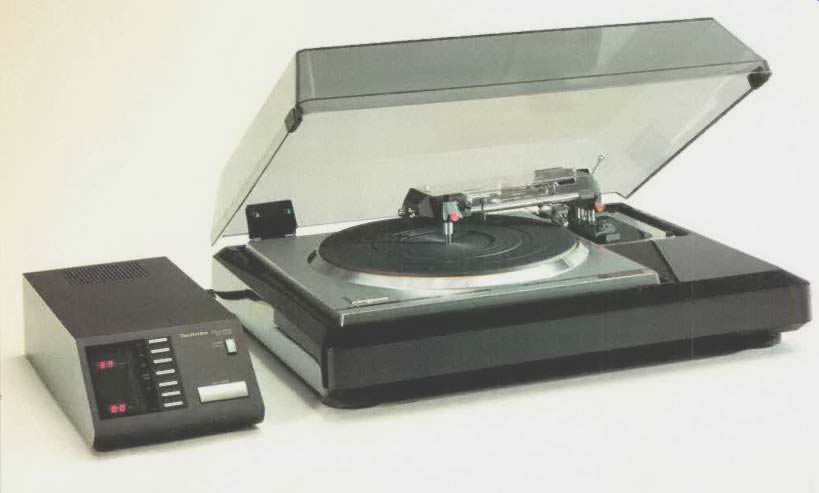
Manufacturer's Specifications:
Drive: Direct.
Motor: Quartz phase-locked control, ultra-low speed, brushless, d.c.
Platter: Copper alloy and aluminum, diecast, 12.6-in. (32-cm) diameter; weight, 22 lbs. (10 kg); moment of inertia, 1.1 ton-cm (1,100 kg-cm).
Speeds: 33.333, 45, and 78.26 rpm.
Pitch Control: Quartz-locked, ±9.9%, in 0.1% steps, at all three speeds.
Starting Torque: 1.2 foot-pounds (16 kg-cm).
Startup Time: 0.25 S to 33 1/2 rpm.
Braking Time: 0.3 S from 33 1/3 rpm.
Speed Fluctuation Due to Load Torque: 0% within 0.72 foot-pounds (10 kg-cm).
Speed Accuracy: ± 0.001%.
Wow & Flutter: 0.015% wtd. rms (per JIS C5521), ±0.021% wtd. peak (per DIN 45-507, IEC 98A weighted).
Rumble: -92 dB DIN B,-60 dB DIN A (both IEC 98A weighted).
Dimensions: Turntable, 14-1/2 in. (36.9 cm) W x 4-7/16 in. (11.3 cm) H x 14-1/2 in. (36.9 cm) D; power/ control unit, 61/2 in. (16.6 cm) W x 313/16 in. (9.6 cm) H x 16 1/4 in. (41 cm) D; optional SH-10B5 base, 22 in. (55.9 cm) W x 18 in. (45.7 cm) D x 63/4 in. (17.6 cm) H including dust cover.
Weight: Turntable, 40 lbs. (18 kg); power/control unit, 13.2 lbs. (6 kg); optional SH-10B5 base, 42 lbs. (19.1 kg).
Prices: Turntable and power/control unit, $1,700; SH-10B5 base, $800.
Company Address: One Panasonic Way, Secaucus, N.J. 07094.
The SP-10MK3 is produced by Technics, a division of Matsushita Electric Industrial Co. Ltd., the Japanese company which also owns Panasonic and Quasar. Matsushita is a large, vertically integrated company, which means that it manufactures most of the parts used in the products it produces. Technics makes a full line, including receivers, amplifiers, loudspeakers and tape decks.
There has been a debate, over the years, as to the relative merits of direct-drive, belt-drive and quartz-controlled turntables. Technics makes all three types and therefore is in a unique position to make judgments about which is best. For the SP-10MK3, their top turntable, Technics has chosen to use quartz control and direct drive.
Direct drive allows very tight coupling between the motor and turntable platter, and therefore very precise control. To maintain precise motor speed, and thereby take advantage of such tight coupling, Technics uses quartz control. In this, a quartz crystal is used as a very stable control element in a high-frequency oscillator. The oscillator is then used as a reference to control the drive motor's very low rotational speed. (The exact control method can vary from one design to another.) The advantage of such an approach is in the ability to control the speed and to allow it to be changed in a very precise manner.
One very impressive thing about the SP-10MK3 is its weight. It is by far the heaviest turntable that I have ever tested, and I have had to lift some big ones! The immediate problem was to find a wide and stable platform upon which to place the SP-10MK3. Many of the turntables I have seen lately are so large and heavy as to cause the same problems as those "bookshelf" speakers not designed to fit on normal bookshelves. The Technics SP-10MK3 is much too heavy for any bookshelf I have ever seen. The weight of the SP-10MK3 turntable is 40 pounds, the control unit is 13 pounds and the mounting base is 42 pounds, for a total weight of 95 pounds! Technics obviously feels that the way to make a turntable immune to external vibrations is to make it massive. For past reports, I have placed the turntable under test on a special massive platform when I was measuring .acoustical and mechanical isolation. With the SP10MK3, I even made the listening tests with the turntable on this platform.
The electronic speed-control unit is also most interesting. There are eight control buttons plus the a.c. power switch and a large display window. Three of the buttons are for selecting the exact speeds; one is the speed lock, three more are for the plus and minus increments and a "clear" switch. The last control button is "Stop-Start." There is a rather large window on the left side of the control unit through which you can see the speed you have selected, and, if you decide to set the speed fast or slow to change pitch, you can see the percentage change in 0.1% increments as you increase or decrease the speed. If you have an interest in 78-rpm records, which I do, you will like the fact that the SP-10MK3 not only has the usual 33.3 and 45 but 78 rpm as well. The electronic speed adjustment will thus allow you to adjust the pitch of the sound to compensate for the old 78-rpm cutting lathes and tape recorders that did not always run at the correct speed.
The optional SH-10B5 turntable base includes a hinged dust cover of smoked gray plastic. The hinges can be adjusted so that the cover can be held open without raising it to its full height. Four feet are mounted on the bottom of the base, and these can be adjusted to level the turntable.
The feet include heavy-duty springs which provide some isolation from external shocks. The black and silver styling of the SP-10MK3 is very clean and functional and gives the immediate impression that it is a very solid, professional turntable.
MEASURED DATA
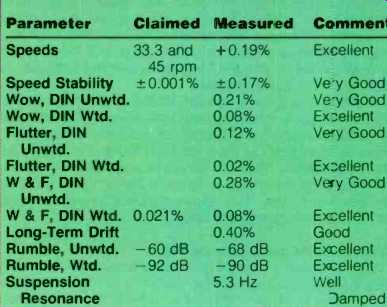
Features
As mentioned before, the SP-10MK3 uses a direct-drive motor, which means that the motor drives the platter without going through any belts or gears. In the case of the SP-10MK3, the motor is part of the platter. The magnetic rotor is mounted on the underside of the platter and is driven by the electric current in the stator coils mounted on the base plate. The platter is made of copper alloy and weighs 22 pounds. Even though it must drive such a heavy turntable, the motor is capable of a starting torque of 16 kg per cm and a moment of inertia of 1.1 ton/sq. cm-quite remarkable. With such torque available, it is no surprise that Technics claims that the platter can reach stable speed within one quarter of a second. By looking at the strobe, I could see that the turntable locked in at 33.3 rpm within one-half turn of the platter. Since the platter makes one complete revolution in 0.56 S at this speed, it appears that the SP10MK3 meets the specification.
A technique called slip cueing is often used in radio stations to start records exactly. To do this, the record is held stationary while the turntable is rotated. At the desired moment, the record is released, and, since the turntable was already running, the start of the sound can be determined very accurately. The SP-10MK3 can do the same thing from a standing start. The stopping time of the turntable is also amazing, considering the mass of the platter, since it comes to a complete halt within 0.3 S after running at 33.3 rpm. The braking is both electrical and mechanical.
The speed can be locked to the standard speeds of 33.3, 45, and 78.26 rpm or it can be adjusted to ± 9.9% of each of these speeds in 0.1% increments. The increment is chosen by holding down either the "+" or "-" button on the control unit. Technics includes a chart which will allow you to determine the percentage of change in frequency or the change of pitch in percentage points. As an example, a change of speed from 33.3 rpm by + 5.9% will cause a pitch change of a half-tone sharp, and a change of 5.6% will cause a pitch change of a half-tone flat. Adjusting the speed this way allows a recording to be set to the exact pitch originally intended and also allows one to play along in tune with the recording. A "clear" key allows the speed to be reset immediately to the exact rated speed. If you place the control unit next to the turntable, you will need a surface about 29 inches wide and 21 inches deep, and there should be a clearance of about 17 inches above the turntable to allow the cover to be opened.
Mounting a tonearm to the SP-10MK3 is facilitated by the fact that separate mounting platforms are provided with the SH-10B5 mounting base. One of the two that I received had a hole for mounting the Technics EPA-100MK2 tonearm; the other was blank. After the tonearm was fastened to the mounting platform, it was secured to the turntable base by four hex-head bolts. This allows different tonearms to be preset and then changed easily.
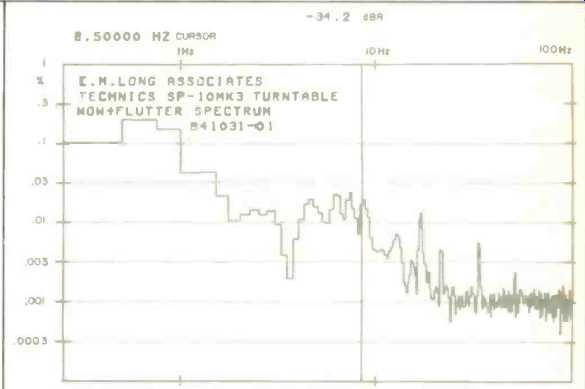
Fig. 1--Wow and flutter spectrum. Note that the vertical percentage scale
has been shifted from previous Long turntable reports so that 1% is the
maximum level on this scale.
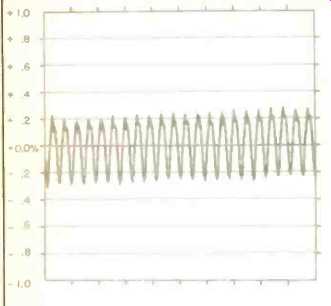
Fig. 2--Speed drift over a 41-S period. The 1.8-S cycle is 5.6 Hz and related
to a single revolution at 33.3 rpm. Drift varies between +0.24% and-0.25%.
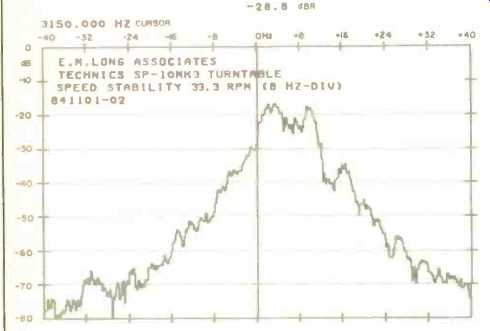
Fig. 3--Speed stability. The 0-Hz reference is to the 3,150-Hz tone on the
B & K 2010 test record. Note that speed tends to be fast.
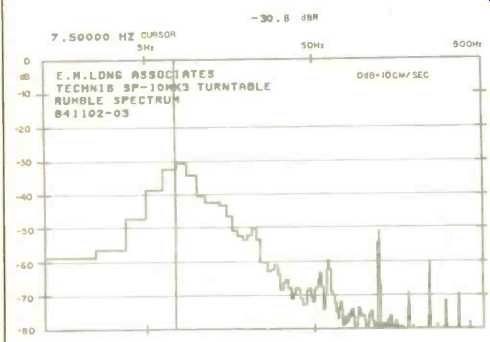
Fig. 4--Rumble spectrum, with main output at the 7.5-Hz tonearm/cartridge
resonance.
Measurements and Listening Tests
As I mentioned earlier, all the measurements and listening tests were conducted with the Technics SP-10MK3 turntable mounted to the SH-10B5 base and with the combination placed on a very heavy and stable platform.
The wow and flutter was measured with a W&F meter and also by recording the component spectrum using the Nicolet 660-2D Fast Fourier Transform (FFT) Analyzer. Figure 1 shows the spectrum of the wow and flutter from the FFT. Most of the components are below 0.03%, and the cursor indicates -34.2 dB, which is 0.02%, at 8.5 Hz. The main component of the wow and flutter spectrum is at about 0.5 Hz. When the record groove is not perfectly centered, the stylus will read the signal at 0.56 Hz, which is the frequency of rotation at 33.3 rpm. This causes the wow modulation seen in Fig. 1, and the accuracy of centering the record has a definite effect upon the amount of wow. The "Measured Data" table shows that the unweighted wow and flutter is 0.28%, while the weighted wow and flutter is only 0.08%. Since the weighting has the effect of reducing the effect of wow and flutter below 20 Hz, this corroborates the data presented in Fig. 1.
The drift in speed over a 40-S period is shown in Fig. 2, a digital storage oscilloscope plot. There is an indication of a little "hunting" by the servo when the speed increases above + 0.2%. This might be the reason for the components which appear at frequencies above 10 Hz in Fig. 1. Drift, displayed in Fig. 2, is minor and indicates that overall rotational speed is slightly fast. During the listening sessions, there were no comments regarding the sound that could be directly linked to lack of stability in tone when compared to the reference system. It is rather difficult, however, to be absolutely certain that a record is perfectly centered during listening tests, at least to the degree possible during the technical measurements. I did try a separate experiment to check this. I offset the record slightly on one turntable while I carefully centered a duplicate on the other.
When I did this, there was one comment from a panel member about a difference in clarity. I heard a difference also, but I discount my own conclusions to a great extent because I was aware of the test conditions. This might be a clue to explain a phenomenon reported by reputable persons that they have heard an effect upon clarity when the record is rotated to a different position relative to the platter.
Figure 3 shows the spectrum due to playing a recorded 3,150-Hz tone and indicates that the SP-10MK3 is running slightly fast in the 33.3 rpm quartz-locked mode. This is shown as +0.19% in "Measured Data." What this means is that a record which should be exactly 60 minutes when played at 33.3 rpm, will take 59 minutes and 53.2 seconds.
This is excellent long-term stability and could be made almost perfect by setting the speed back two clicks to -0.2%. Precise control of speed is very important for timing broadcasts, but it is also handy when copying a record to tape because it can be used to avoid running out of tape at the end of a piece of music. The cyclical variation in speed, shown in Fig. 3, is not the best I have measured, but it is more a function of record eccentricity than of actual speed variations in the turntable itself. Still, the performance here is very good and translates to the ± 0.17% shown for speed stability in "Measured Data." The claimed spec of ± 0.001% may be a typographical error since it is easy to mix decimal points and percentages. I know, because I tend to fall into this trap myself!
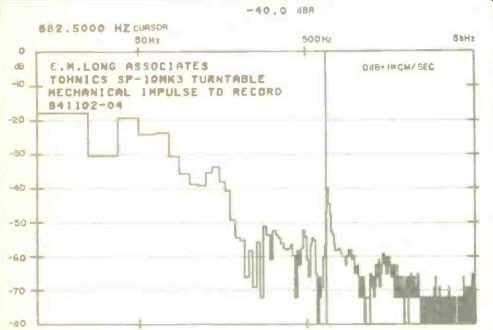
Fig. 5--Spectrum to 5 kHz due to a mechanical impulse applied to the edge
of a stationary record with the stylus in a is at 662.5 Hz, which is the
main ringing frequency of the platter and where the output is -40.0 dB below
10 cm/S.
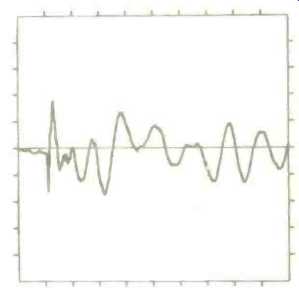
Fig. 6--Output vs. time of the impulse used to obtain the spectrum in Fig.
5. Total period is 0.205 S.
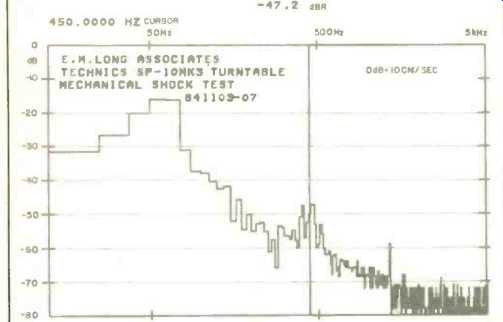
Fig. 7--Spectrum to 5 kHz due to mechanical shock applied to the massive
platform upon which the turntable and base rested during tests. Resistance
to such shock was very good.
The rumble spectrum is shown in Fig. 4. Most of the rumble is at the 7.5-Hz tonearm/cartridge resonance frequency. The unweighted and weighted rumble specs are shown in "Measured Data" as being 68 and 90 dB, respectively; Technics claims values of -60 and-92 dB. The rumble is so low that only the most sophisticated equipment and techniques will allow it to be measured with any accuracy, and it has to be rated excellent.
Figure 5 shows the averaged spectrum produced by a series of mechanical impulses. These impulses were applied to the edge of a stationary record while the stylus was resting in a quiet groove near the middle of the record.
Figure 6 shows the output versus time caused by one of the mechanical impulses picked up by the stylus. Technics doesn't supply any type of record clamping device, so I didn't use one on the SP-10MK3 for these measurements.
During the listening tests, no clamping device was used on either the SP-10MK3 or the reference turntable. The stock platter mat doesn't appear to be anything special, but it is effective in suppressing the ringing of the metal platter at 662.5 Hz. During the listening tests, comments were made about differences in tonal balance between the SP-10MK3 and the reference turntable. It was felt that these differences might be related to differences in the spectrum of the energy in the record. For example, the sound of acoustical guitar seemed a bit fuller from the SP-10MK3, which shows more energy in the range below 200 Hz than the reference turntable.
The isolation of the SP-10MK3 from external shock is indicated by the spectrum shown in Fig. 7. The cursor is at 450 Hz, and the energy rise at this frequency is down -47.2 dB. The greatest amount of energy is concentrated below 100 Hz. The suspension resonance of the SH-10B5 is at 5.3 Hz and very damped, but the great mass of the system can be energized by external shock. Therefore, care was taken during the listening sessions to avoid any mechanical coupling between the loudspeakers and the turntables. Figure 8 shows the output versus time for the mechanical shock which produced the spectrum shown in Fig. 7.
Figure 9 shows the spectrum of the electrical output of the cartridge with the stylus resting in a quiet groove while an acoustical signal produces a level of 100 dB at the surface of the record. This signal is a very slow sweep from 20 to 100 Hz. The system's degree of isolation from this acoustical signal is excellent.
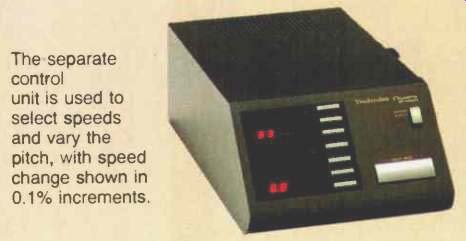
Conclusions
The SP-10MK3 is offered by Technics as being the best turntable that they make; it is certainly among the best turntables presently offered by anyone. If you are in the market for a rugged, heavy-duty turntable which will hold up well in day-after-day use and has broadcast-type professional features, you should check it out. The overall sound quality is only slightly below that of a few top audiophile turntables, and the SP-10MK3 is as good as the best of them with regard to acoustical isolation. In order to achieve this performance, you will have to place the turntable and its base on a very solid platform. The precise control of speed and the ability to change tonearms easily are great features which should interest both musicians and audiophiles.
-Edward M. Long
(Source: Audio magazine, Feb. 1985)
Also see:
Warp Out Record Weight (Sept. 1979)
Technics SL-QL1 Turntable and P22S Moving-Magnet Phono Cartridge (Nov. 1981)
Technics EPC-305MCII Cartridge and SH-305MC Transformer (Aug. 1986)
= = = =